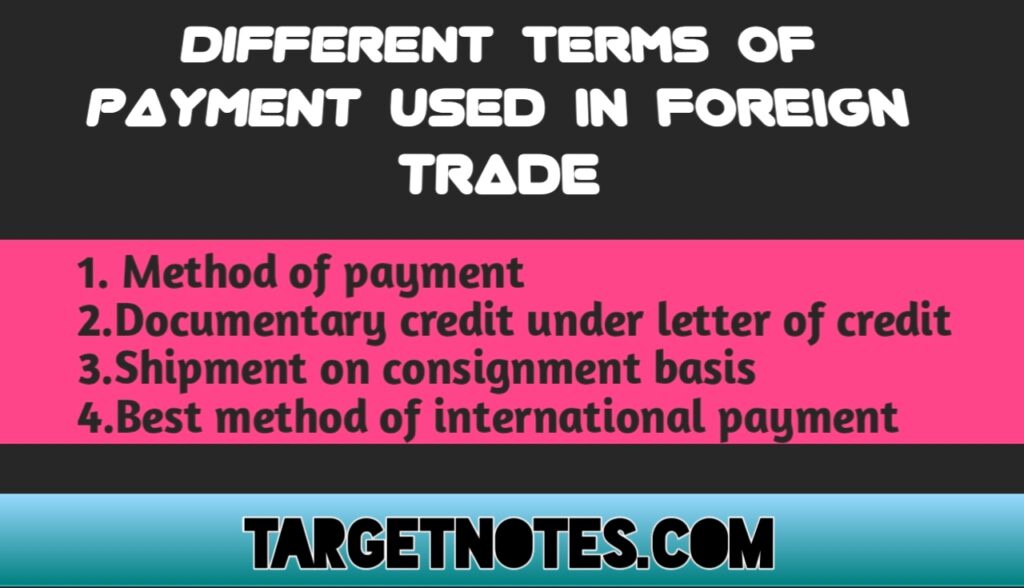
Different Terms of Payment used in Foreign Trade
Contents
Methods of Payment
The international market is very sensitive and competitive. The extent to which credit can be given depends on the sale terms. When an exporter gets payment in advance, there will not be any problem relating to finance. If sale is made on credit, it requires credit to meet its pre-shipment and post-shipment financial requirements. Institutional credit can be extended to foreign buyers.
Following things should be kept in view while deciding about the terms of payment:
1. Importer’s/buyers financial position,
2. Competition faced by the exporter/seller,
3. Cost involved in receiving payment,
4. Seller’s/exporter’s knowledge of the buyer/importer,
5. R. B. I’s caution list,
6. Security of payment’s position,
7. Exchange restriction in the importing country etc.
Following are the methods of payment:
1. Payment in advance
2. Open account
3. Documentary bills
4. Documentary credit under L/C
5. Shipment on consignment basis.
(a) Payment in Advance – A sale contract should clearly specify when, where and how the payment will be made under the payment in advance method, a bank draft or bank advice is received by the exporter at any time before confirmation of the order or shipment.
It is the most beneficial form of payment for the exporter. But this is the most uncommon method. Importer can made advance payment –
- If there is heavy demand of the goods.
- If the goods are tailor made.
The exporter/seller may also insist upon advance payment in the following cases –
- When political conditions are unstable in the buying country.
- The importer’s credit standing is unsound.
(b) Open Account – The exporter sends the documents to the overseas buyer. The exporter does not draw any bill of exchange. The exporter ships the goods with no financial documents except the commercial invoice. The importer is allowed a credit period. Importer makes payment on the expiry of the credit period.
This is a simple method and it avoids extra changes.
Under this method burden of finance is carried by the exporter. It involves real risk for the exporter.
Documentary Bills
The documentary bills finance a large part of international trade The seller/exporter agrees to submit the documents to his bank along with the bill of exchange. These document involved bill of lading, marine insurance policy and invoice etc.
Types of Payment under Documentary Bills –
There are two types of payment under documentary bills :
- Documents against payment (D/P)
- Documents against acceptance D/A).
Under D/P bills, the exporter’s bank sends the documents to its correspondent bank in the importer’s country. This bank presents the documents to the importers.
In the case of D/A bills, the correspondent bank sends the bill of exchange to be signed by the buyer.
Under D/A bills, the exporter waits for payment till the bill is finally paid for.
D/P and D/A bills are common in export trade.
Documentary Credit under Letters of Credit
According to International Chamber of Commerce, “any arrangement, however named or described, whereby a bank (the issuing bank) acting at the request and in accordance with the instructions of a customer (the applicant for the credit) (i) is to make payment to or to the order of a third party (the beneficiary) or is to pay, accept or negotiate bills of exchange (Drafts) drawn by the beneficiary, or (ii) authorises such payment to be made or such drafts to be paid, accepted negotiated by another bank against stipulated documents, provided that the terms and conditions of the credit are complied with.”
(a) and (b) Irrevocable and Revocable Credit
Revocable letter of credit is not popular. Under revocable letter of the importer’s bank states that the credit can be revoked at any time, This credit not protect the interest of the exporter. Under irrevocable credit above problem does not arise. Under irrevocable credit the bank irrevocably commits itself to make the payment.
The exporter can feel secure about the payment because it cannot be cancelled.
(c) and (d) Confirmed and Unconfirmed Credit
Exporter to reduce his payment risks, he wants commitment that a local bank in his own country itself to make the payment on presentation of the documents. The importer’s bank asks its correspondent bank to confirm the original credit. The correspondent bank adds the following clause to the effect that:
“The above credit is confirmed by us and we hereby undertake to honour the drafts drawn under this credit on presentation provided that all the terms and conditions of the credit are duly satisfied.”
When the letter of credit is irrevocable but not confirmed, the issuing bank asks the correspondent bank to advise about the letter of credit without any confirmation of the latter. In such a case, the advice of the correspondent bank will contain a clause that:
“This credit irrevocable on the part of issuing bank but is not confirmed by us and therefore it does not involve any undertaking on our part.”
Shipment on Consignment Basis
The exporter makes shipment but retains the title to the goods. The payment is made when the goods are ultimately sold by the consignee to other parties, Exporter may be faced with a cash flow problem. When consignee fails to sell he may return the goods. The price is also uncertain and will depend on market. Following points may be noted:
- Shipments on consignment basis should be made to reliable agents.
- The exporter declare the expected value of the goods consigned in the G R form.
(a) Institutional Finance or Credit for Export-Pre- shipment and Post-shipment – Pre-shipment finance refers to the credit extended to the exporter prior to the shipment. Pre-shipment credit enables the exporter to meet working capital requirements. It is also called as packing credit. It is short-term finance.
It is provided by Indian and foreign commercial banks. The RBI runs the Packing Credit Scheme. The main features of this scheme are as under:
1. The loan is provided only on receipt of an export order,
2. The exporter has to deliver to the bank or a confirmed export order.
3. Packing credit is given against export incentives.
4. Packing credits are eligible for interest subsidy, normally for a 90 days, or for a period of 180 days.
(b) Post-Shipment Credit – Post-shipment credit is required by the exporter after the shipment of goods and before receiving payment from the importer. It includes advances. This credit facility is provided to shift the burden of credit from exporter to financial institutions providing credit directly or indirectly, to the importer or by extending credit to the exporter to enable them to extend credit to their buyers.
Best Method of International Payment
Here question arises what is the best method of international payments. Actually there is no method which can be regarded as best. International payment method be used per time, circumstances, amount of payment, terms of agreement etc. Payee will like such method by which he can receive maximum. Payment without risk of exchange rate fluctuation. Payment method should be free from political risk. Generally payment by bill is more popular. Payment by documentary bill is more popular and safe.
- Letter of Credit: Meaning, Importance and Required Document
- Documents used in export trade its types and contents
- Restrictions on deposits to foreign currency accounts
- What is the obligation to submit foreign currency?
- Foreign Exchange: Concept, Example and Needs
Disclaimer






